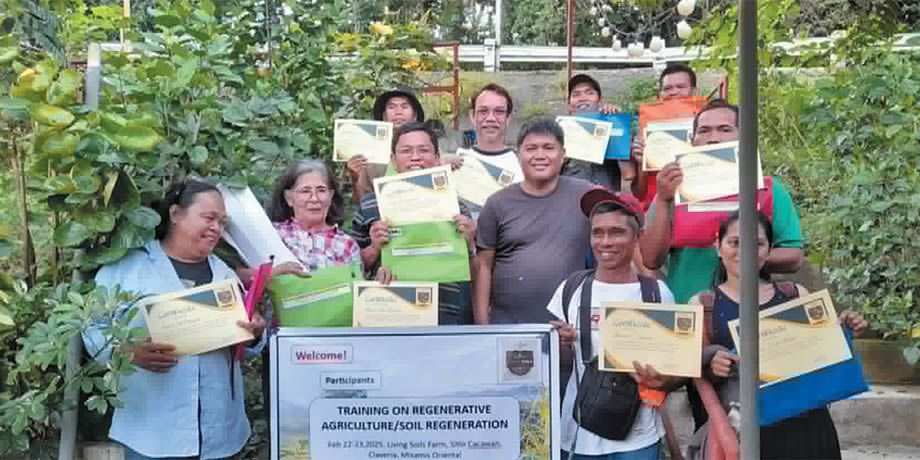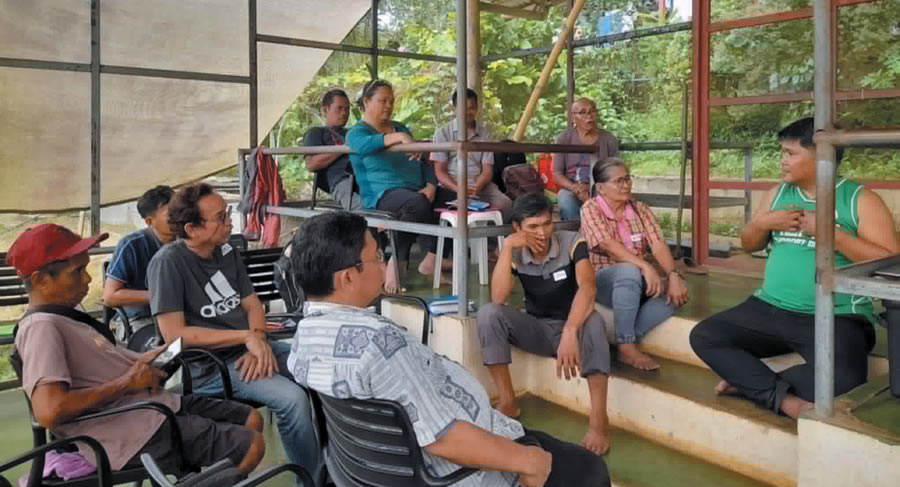
A training on Regenerative Agriculture/soil regeneration was conducted and held at Living Soils Farm, Sitio Kakawan, Patrocenio, Claveria, Misamis Oriental, Philippines, February 22- 23, 2025. The training was attended by no less than ten key leaders of organizations from different places in Mindanao. These key leaders have been engaged in various initiatives for the protection and care of the environment through agroecological, climate-resilient farming practices.
The training objective was to find new inspiration, to rekindle, and renew the interest of these key leaders who have been working, practicing, and promoting natural, organic, agriculture in rural areas; obtain the latest updates on the Philippine agricultural situation as well as updates on organic agroecological and soil regeneration practices; reflect and deepen understanding of the roles and functions of soil microorganisms in sustaining agriculture; and its strategies for application and wider adoption of communities.
The participants were amazed at the whole training. It was held in a venue where one can see directly the living proof of what it preaches: healthy plants grown with the use of naturally produced indigenous microorganisms. Different plants such as corn, peanuts, tomato, string beans, sweet potato, and many more are grown healthy at Living Soils Farm, with the use and application of tailored-fit/made, science-based compost and biosolutions. Farmers witness the actual soil transformation process for better yield and healthy plants. This method has been developed and enhanced by the Living Soils Farm led by Gerry Burdas, who recently studied Soil Food Web System in California, U. S.
The training navigates participants to the current and updated soil tools and materials, from simple tools like tie-wire to determine the compaction of soils to sophisticated ones, like microscopes. Then the how-to and “why” aspects of regenerating, revitalizing, or healing the soil followed. The current agricultural context and situation were discussed by Bobby M. Pagusara, former Coordinator of MASIPAG-Mindanao and Agroecology Consultant of the Swiss Catholic Lenten Fund (Fastenaktion) projects in the Philippines, which serves as the rationale for why this training is relevant and important.

The participants realized that it all boils down to the basic premise, God created everything good and perfect. The soil is perfect. It has a complete and balanced ecosystem with beneficial and non-beneficial microbes such as bacteria, fungi, and nematodes, that live on by eating harmful bacteria, fungi, and nematodes thereby neutralizing or preventing bad microbes from causing sickness and diseases in plants.
As a result of this process, the wastes or excretes, which include minerals/nutrients eaten by bacteria and fungi become the yummy food or available food nutrients for the plants, thus, making plants grow very well. Billions of beneficial bacteria-protozoa, fungus-mycelium, and nematodes are found in soils not sprayed/applied with synthetic agrochemical fertilizers and pesticides.
Each microbe or group of microbes must be connected to the other to perform this function or task. Different kinds of microbes and minerals should be together to produce the desired result, which is making minerals and nutrients available for plants and preventing bad microbes from harming or infecting the plants. This can happen only when they are together as a community. But agrochemicals disrupt this mutual and symbiotic functioning process because all microbes good and bad are destroyed or killed by synthetic chemical fertilizers and pesticides. So natural organic farming is right, and it is the right way to manage agriculture.
Good soil is indicated by having many clusters of microbial communities bonded together, as observed by participants through the microscope during training. When organisms are in communion, good things happen. This is also the challenge to human organisms, the homo sapiens, we need to group ourselves and unite as universal clusters of communities under a common purpose of restoring the soil, of caring for the environment. We strive to do this in the best way possible following the most perfect model of communion: God the Father, God the Son, and God the Holy Spirit.
The participants were highly inspired and motivated to continue doing organic farming and/or regenerative agroecological methods to help mitigate climate change, and to care for the environment, the health and life of people, and the world. According to one of the participants, Greg Tacbas,who is a farmer leader and a local Church Lay minister:
“For me, the training is very reaffirming and extraordinary training I’ve ever attended. In the sense that it reconfirms, and provides sufficient proof of my previously gained knowledge in the field of sustainable/organic/DIFS (Diversified and Integrated farming System) agriculture. Because of this, I am so inspired to pursue and more motivated and aggressive towards agroecology. Thank you very much Fr. Oliver McCrossan and your friends for organizing/sponsoring/supporting this training, to our scientist resource person Sir Gerry Burdas and Bobby Pagusara, for coordinating/organizing this training.”
Columban Fr. Oliver McCrossan provided this update.